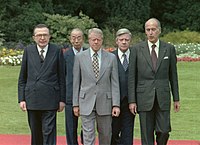Two-level game theory

Imagine you're playing a game of hide and seek with your friends. You want to hide, but you also want to make sure your friends can't find you. This is a bit like two-level game theory!
In two-level game theory, there are two levels or layers of decision-making. The first level is between someone like you and your friends, and the second level is between you and someone else outside your group.
Let's say you and your friends are playing hide and seek outside, and it's starting to rain. You and your friends might decide to stop playing and go inside, but your parents may say you have to stay outside until dinner time.
So, in this example, you and your friends are the first level. You want to stop playing and go inside to avoid getting wet, but you also don't want your friends to think you're a party pooper. Meanwhile, your parents are the second level. They want you to stay outside so dinner is ready on time, but they also don't want you to get sick from being in the rain.
In two-level game theory, you have to think about all the levels and how the decisions made at one level affect the decisions made at another level. To make the best decision, you have to think about what everyone wants and needs, and how you can work together to make everyone as happy as possible.
So, to apply this to our hide and seek example, you might suggest moving the game to a covered area so you can keep playing but avoid getting too wet. This way, you make your friends happy because they get to keep playing, and your parents are happy because they know you won't get sick. This is an example of two-level game theory in action!
In two-level game theory, there are two levels or layers of decision-making. The first level is between someone like you and your friends, and the second level is between you and someone else outside your group.
Let's say you and your friends are playing hide and seek outside, and it's starting to rain. You and your friends might decide to stop playing and go inside, but your parents may say you have to stay outside until dinner time.
So, in this example, you and your friends are the first level. You want to stop playing and go inside to avoid getting wet, but you also don't want your friends to think you're a party pooper. Meanwhile, your parents are the second level. They want you to stay outside so dinner is ready on time, but they also don't want you to get sick from being in the rain.
In two-level game theory, you have to think about all the levels and how the decisions made at one level affect the decisions made at another level. To make the best decision, you have to think about what everyone wants and needs, and how you can work together to make everyone as happy as possible.
So, to apply this to our hide and seek example, you might suggest moving the game to a covered area so you can keep playing but avoid getting too wet. This way, you make your friends happy because they get to keep playing, and your parents are happy because they know you won't get sick. This is an example of two-level game theory in action!
